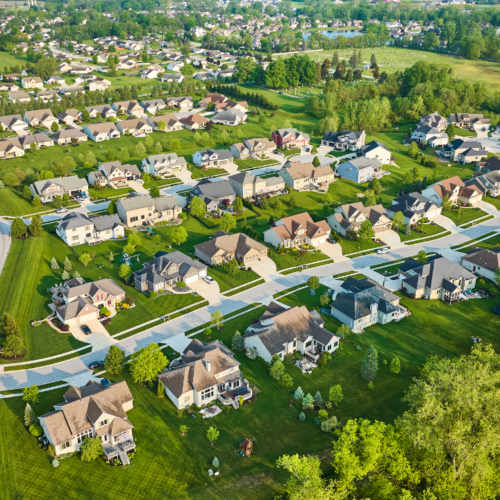With Biodiversity Net Gain (BNG) regulations now mandatory for most new developments, housebuilders and urban planners face new opportunities (and challenges) in enhancing onsite biodiversity while reducing reliance on offsite biodiversity units.
Data shows that since 1970, UK species have declined by an average of 19%, with nearly one in six facing extinction. By incorporating BNG into development plans, housebuilders can not only contribute to reversing this concerning trend but can also enjoy economic benefits, as homes within 100 metres of green space can be worth up to £2,500 more than those further away.
In this guide, our experts at Thomson share practical insights and innovative strategies to meet BNG requirements, offering developers an approach considering the ecological landscape and the often-overlooked skills gap in effective BNG planning and implementation.
Proactive planning for onsite biodiversity
One of the most effective ways to meet BNG targets is by engaging in an ecological assessment early in the planning process. Our Associate Director of Nature Markets, Gregor Neeve, advises that developers can make more informed decisions on site layout and landscaping by doing this from the outset. This early intervention allows for habitat-sensitive construction that prioritises higher biodiversity value while designating less sensitive areas for development.
This early input also helps guide landscape design, encourages using habitat types and native species that thrive long-term, and contributes to meaningful BNG enhancements. For example, planting a species-rich hedgerow of native plants has a more significant ecological impact than choosing non-native options, creating long-lasting habitats for local wildlife.
Urban greening to enhance onsite biodiversity
Urban greening, which uses trees and green spaces within developments, offers a sustainable way to enhance onsite biodiversity efforts. For example, trees contribute to urban ecosystems by providing shade, creating wind buffers, and serving as habitats for species, including birds, bats and insects. Trees also help to absorb environmental pollutants, mitigate flooding risks, and store carbon, helping to combat climate change effects.
At Thomson, we’ve noticed that homeowners highly value green and blue spaces, and developments with these spaces often see higher property values and healthier communities. These benefits make urban greening a priority for sustainability and its social and economic impact.
Green and blue infrastructure’s role in onsite biodiversity
Green and blue infrastructure has become integral to urban planning in recent years. These spaces, which include parks, rivers, and wetlands, are now supported by government initiatives, including the Environmental Improvements Plan’s goal for homeowners to live within a 15-minute walk of green or blue infrastructure.
With this in mind, BNG is a good way to promote sustainable city planning and provide local authorities with funds. Developers can use this initiative to create urban spaces that balance natural and urban environments, meeting regulatory requirements and community needs.
Drainage solutions to address flood risk and support biodiversity
The UK continues to experience heavy rain and flooding yearly, and sustainable drainage solutions (SuDs) are critical for managing this in urban areas. These drainage systems reduce surface water runoff, improve water quality and support local biodiversity. These systems are crucial for areas like the West Midlands, where flood risk is high.
These nature-based solutions give developers a clear pathway to achieve BNG goals while mitigating the risk of floods. By using this innovative nature-based solution, developers can protect vulnerable areas and create green spaces that benefit both the environment and residents within these areas.
Addressing the Ecology Skills Gap
As BNG regulations become more complex, ecology professions face significant skills gaps. Recent insights highlight that fewer than 10% of professionals feel fully equipped with the knowledge and resources required to deliver effective BNG. This gap presents opportunities for organisations like ours to lead the way in end-to-end BNG planning.
The skills gap lies in the knowledge of the entire planning process and the ability to design biodiversity-friendly habitats that are practical and cost-effective. Generally, traditional ecological consultancies tend to focus heavily on surveys and reporting, while at Thomson, our interdisciplinary team combines ecological consultancy with hands-on habitat creation and management. This approach allows us to provide clients with seamless processes from initial assessments to long-term habitat management. Our approach offers clients an efficient and effective ‘one-stop’ solution for BNG.
By taking advantage of our integrated approach, we can ensure that biodiversity units are achievable on the ground. By aligning projects with regulatory standards and local site requirements, we can help clients avoid costly design adjustments later in the process.
Unfortunately, a third of local planning authorities in England currently lack in-house ecologists, leaving them unprepared for BNG requirements. Our experts at Thomson help to bridge this gap by offering guidance to local authorities and developers alike, which makes the planning process more seamless and helps clients anticipate any regulatory challenges.
Bushfield camp
Thomson has led several projects where we have worked with clients to maximise the biodiversity value of their sites through careful design.
Bushfield Camp is a good example of a development that delivers significant on-site BNG that will also serve as valuable community space.
Bushfield Camp is set to become a new research and development hub that prioritises sustainability and benefits the local community. The project will repurpose a 44-hectare site south of Winchester, designated by the local council for “employment-led mixed-use development.” The aim is to create a vibrant space for offices, R&D facilities, academic buildings, and amenities like a hotel, cafes, and shops. This blend of uses will make Bushfield Camp an active and accessible destination.
The design includes plenty of green spaces and features that will improve biodiversity, such as natural drainage systems, wildlife-friendly landscaping, and public areas for recreation. The northern part of the site, which locals have used informally, will remain a green area with new cycle paths, while the southern section will undergo redevelopment on roughly 20 hectares.
Importantly, Bushfield Camp’s focus on enhancing local biodiversity aligns with its designation as a Site of Importance for Nature Conservation. At Thomson, we’re helping ensure that the project’s development plan supports local wildlife and natural ecosystems. With these efforts, Bushfield Camp will offer a modern research park that values nature and community, providing both economic growth and environmental benefits.
Nature markets and standards in biodiversity
Nature markets offer a good avenue for filling the ecology skills gap by assigning value to ecosystems’ services. With the UK government’s goal of attracting £1 billion in private investment for nature recovery, Thomson is closely involved in developing the standards needed to uphold the integrity of nature markets. These standards, informed by ongoing work with DEFRA and BSI, will provide clear carbon, biodiversity, and nutrient credit guidelines. While these standards won’t solve the skills gap, they will offer much-needed structure to support BNG professionals.
With early ecological input, thoughtful planning, and implementation of innovative BNG solutions, developers can deliver new schemes, achieve a net gain for onsite biodiversity and maintain a resilient urban landscape.
To find out more about Biodiversity Net Gain (BNG) and Thomson Environmental Consultants services, please visit: https://www.thomsonec.com/services/ecology-services/biodiversity-net-gain-bng/






